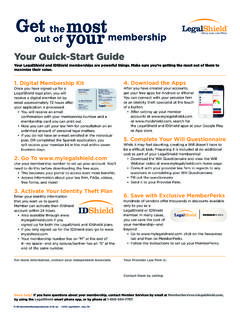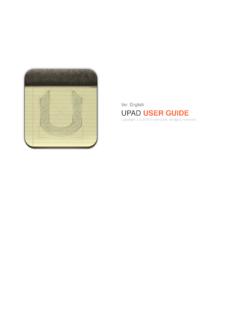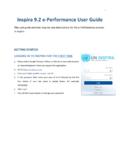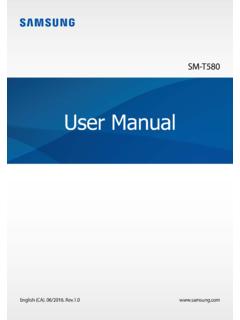Transcription of User’s Guide - Infinitec
1 1 user s Guide Contents Get started 3 Get around 3 Touch & type 4 Use the lock screen 5 Make yourself at home 6 Change the wallpaper 6 Arrange & work with apps 7 Use folders 8 Add widgets 9 Try some apps 9 Find People 10 Manage your Calendar 12 Use your Camera 13 Manage downloads 13 Tune performance 14 Optimize battery life 14 Optimize data usage 14 Optimize memory usage 19 Use the apps screen 20 Enter & edit text 21 Use the keyboard 22 Basic editing 22 Tips & shortcuts 23 2 Connect to Wi-Fi networks 24 Connect to keyboards, mice, and other devices 28 Connect to a Windows computer via USB 29 Manage accounts 30 Add or remove accounts 30 Configure account sync options 32 Configure general sync settings 32 Change an account s sync settings 33 Secure your tablet 33 3 Get Started Get around After you enter into the systems, at the bottom of the screen, you'll find three Navigation buttons.
2 They're always available. No matter what you're doing with your tablet, you can always get back to the main Home screen or return to previous screens: Icon Name Description Back Open the previous screen you were working in, even if it was in a different app. Once you back up to the Home screen, you can t go back any further in your history. Home Open Home. If you re viewing a left or right Home screen, opens the central home screen. Recent apps Opens a list of thumbnail images of apps you ve worked with recently. Top open an app, touch it. To remove a thumbnail from the list, swipe it left or right. 4 After a short time without getting used, these buttons may shrink to dots or fade away, depending on the current app.
3 To bring them back, touch their location. The All apps icon in the right upper corner is permanent. Touch it to see all your apps and widgets. The middle of your Home screen can hold app and widget icons, plus folders. To open an app, folder, or widget, touch its icon. To see additional Home screens, swipe your finger quickly left or right. At the bottom of the screen, you'll see something like this: Status icons on the left tell you which apps have sent you notifications; for example, that a message has arrived, or it's time for a meeting. System icons on the right display the current wireless and network connection strength, battery level, time, and more. Touch & type Use your fingers to manipulate icons, buttons, menus, the onscreen 5 keyboard, and other items on the touchscreen.
4 You can also change the screen's orientation. To select or activate something, touch it. To type something, such as a name, password, or search terms, just touch where you want to type. A keyboard pops up that lets you type into the field. Other common gestures include: Touch & hold: Touch & hold an item on the screen by touching it and not lifting your finger until an action occurs. Drag: Touch & hold an item for a moment and then, without lifting your finger, move your finger on the screen until you reach the target position. For example, you can drag to reposition shortcuts on the Home screen. Swipe or slide: Quickly move your finger across the surface of the screen, without pausing when you first touch (so you don't drag something instead). For example, you can slide a Home screen left or right to view the other Home screens.
5 Pinch: In some apps (such as Maps, Browser, and Gallery), you can zoom in and out by placing two fingers on the screen at once and pinching them together (to zoom out) or spreading them apart (to zoom in). Rotate the screen: On most screens, the orientation of the screen rotates with your device as you turn it. You can change this Display setting. Related settings Settings > Device > Sound Settings > Device > Display 6 Use the lock screen To protect personal information, you can adjust your phone's lock settings: 1. From the Home or All apps screen, touch the Settings icon 2. Scroll down and touch Security. 3. Touch Screen lock. 4. Touch the type of lock you'd like to use. After you set a lock here, a lock screen displays whenever your screen wakes up, requesting the pattern, PIN, or other specified key.
6 Important Screen lock options are listed in the approximate order of the strength of their security, starting with None and Slide, which provide no security. Face Unlock and Pattern provide minimal security, although they can be more convenient than the stronger options. If your tablet's playing music when the screen locks, you can continue listening or pause the selection without unlocking. Make yourself at home Change the wallpaper Wallpapers are images from Super-HD Player (pictures you shot with Camera, synced from Picasa, and so on), still images included with the system, and live images (such as an animation or a map 7 that centers on your location). They take the place of the default background for your Home screens.
7 1. Touch & hold anywhere on a Home screen that's not occupied. A list of options appears. 2. Touch a wallpaper source: Super-HD Player. Choose from pictures that you've taken with Camera or downloaded to your device. Live Wallpapers. Choose from a scrolling list of animated wallpapers. Wallpapers. Choose from thumbnails of default images, or touch a thumbnail for a larger version. You can download additional wallpapers from Android Market. 3. To set a wallpaper, touch set wallpaper under the Gallery images or Set wallpaper. Related settings Settings > Device > Display > Wallpaper Arrange & work with apps To see all your apps , touch the All apps icon on any Home screen. The main All apps screen opens. This is where you can see all your apps , including those downloaded from Android Market.
8 You can move app icons to any of your Home screens. From All apps , you can Move between screens: Swipe left or right. Launch an app: Touch its icon. Place an app icon on a Home screen: Touch & hold the app 8 icon, slide your finger, and lift your finger to drop the icon in place. Place an app icon in the Favorites tray: Touch, hold, & slide to move one of the Favorites icons out of the tray. Then use the same technique to move another one into the same position. Explore your widgets: Touch the Widgets tab at the top of any All apps screen. Get more apps . Touch the Market icon. To remove an app icon from the Home screen, touch and hold it, slide your finger toward the top of the screen, and drop the app over the Remove icon . Note The All apps icon in the Favorites tray is permanent.
9 You can't move it. Use folders You can combine several app icons in a folder. Drop one app icon over another on a Home screen, and the two icons will be combined. From any Home screen, you can Open a folder: Touch it. The folder opens: Rename a folder: Touch its name. Move icons around your Home screens: Touch, hold, and 9 slide. Tips To can see a smaller collection of frequently used apps , touch the Google apps folder near the bottom of the screen. As with any folder, you can customize its contents. After you open an app, you can usually adjust its settings by choosing items from its Menu icon near the top or bottom of the screen . Add widgets Widgets are like windows into your apps . They're available from an All apps tab for you to move onto your Home screens.
10 To see your widgets: 1. Touch the All apps icon on your Home screen. 2. Touch Widgets at the top of the screen. From the main Widgets screen, you can Move between screens: Swipe left or right. Drag a widget to a Home screen: Touch and hold the widget's icon, slide your finger where you want to place it, and lift your finger. You may be asked to make further choices before the widget activates. If there isn't room where you dropped it, the widget won't get added to the Home screen. 10 Try some apps Start Gmail You can use Gmail to read and write email from any mobile device or browser. All your email is always up to date and available no matter where you check it from. But Gmail is not just about email. Your Gmail name and password signs you into to all Google apps and services, including Calendar; People, for keeping track of your contacts; Google Reader, for keeping up with your online reading; and many more.







